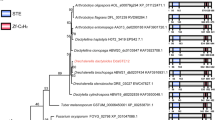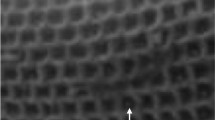Abstract
A key challenge in the successful treatment of Acanthamoeba infections is its ability to transform into a dormant cyst form that is resistant to physiological conditions and pharmacological therapies, resulting in recurrent infections. The carbohydrate linkage analysis of cyst walls of Acanthamoeba castellanii showed variously linked sugar residues, including xylofuranose/xylopyranose, glucopyranose, mannopyranose, and galactopyranose. Here, it is shown that exogenous xylose significantly reduced A. castellanii differentiation in encystation assays (P < 0.05 using paired t test, one-tailed distribution). Using small interfering RNA (siRNA) probes against xylose isomerase and cellulose synthase, as well as specific inhibitors, the findings revealed that xylose isomerase and cellulose synthase activities are crucial in the differentiation of A. castellanii. Inhibition of both enzymes using siRNA against xylose isomerase and cellulose synthase but not scrambled siRNA attenuated A. castellanii metamorphosis, as demonstrated by the arrest of encystation of A. castellanii. Neither inhibitor nor siRNA probes had any effect on the viability and extracellular proteolytic activities of A. castellanii.




Similar content being viewed by others
References
Achar SB, Weisman RA (1980) Adenylate cyclase activity during growth and encystment of Acanthamoeba castellanii. Biochim Biophys Acta 629:225–234
Anderson IJ, Watkins RF, Samuelson J, Spencer DF, Majoros WH, Gray MW, Loftus BJ (2005) Gene discovery in the Acanthamoeba castellanii genome. Protist 156:203–214
Ankel H, Feingold DS (1965) Biosynthesis of uridine diphosphate d-xylose. 1. Uridine diphosphate glucuronate carboxy-lyase of wheat germ. Biochem 4:2468–2475
Dudley R, Alsam S, Khan NA (2008) The role of proteases in the differentiation of Acanthamoeba castellanii. FEMS Microbiol Lett 286:9–15
Dudley R, Jarroll EL, Khan NA (2009) Carbohydrate analysis of Acanthamoeba castellanii. Exp Parasitol 122:338–343
Dudley R, Matin A, Alsam S, Sissons J, Maghsood AH, Khan NA (2005) Acanthamoeba isolates belonging to T1, T2, T3, T4 but not T7 encyst in response to increased osmolarity and cysts do not bind to human corneal epithelial cells. Acta Trop 95:100–108
Henrick K, Collyer CA, Blow DM (1989) Structures of d-xylose isomerase from Arthrobacter strain B3728 containing the inhibitors xylitol and d-sorbitol at 2.5 A and 2.3 A resolution, respectively. J Mol Biol 208:129–157
John KV, Schutzbach JS, Ankel H (1977) Separation and allosteric properties of two forms of UDP-glucuronate carboxy-lyase. J Biol Chem 252:8013–8017
Lee CY, Bagdasarian M, Meng MH, Zeikus JG (1990) Catalytic mechanism of xylose (glucose) isomerase from Clostridium thermosulfurogenes: characterization of the structural gene and function of active site histidine. J Biol Chem 265:19082–19090
Lorenzo-Morales J, Kliescikova J, Martinez-Carretero E, De Pablos LM, Profotova B, Nohynkova E, Osuna A, Valladares B (2008) Glycogen phosphorylase in Acanthamoeba spp.: determining the role of the enzyme during the encystment process using RNA interference. Eukaryot Cell 7:509–517
Martin SM, Byers TJ (1976) Acid hydrolase activity during growth and encystment in Acanthamoeba castellanii. J Protozool 23:608–613
Matin A, Stins M, Kim KS, Khan NA (2006) Balamuthia mandrillaris exhibits metalloprotease activities. FEMS Immunol Med Microbiol 47:83–91
Mehdi H, Garg NK (1987) Changes in the lipid composition and activities of isocitrate dehydrogenase and isocitrate lyase during encystation of Acanthamoeba culbertsoni strain A-1. Trans R Soc Trop Med Hyg 81:633–636
Moon EK, Chung DI, Hong Y, Kong HH (2011) Expression levels of encystation mediating factors in fresh strain of Acanthamoeba castellanii cyst ESTs. Exp Parasitol 127:811–816
Moon EK, Chung DI, Hong YC, Kong HH (2007) Differentially expressed genes of Acanthamoeba castellanii during encystation. Kor J Parasitol 45:283–285
Moon EK, Chung DI, Hong YC, Ahn TI, Kong HH (2008) Acanthamoeba castellanii: gene profile of encystation by ESTs analysis and KOG assignment. Exp Parasitol 119:111–116
Neff RJ, Neff RH (1969) The biochemistry of amoebic encystment. Symp Soc Exp Biol 23:51–81
Potter JL, Weisman RA (1972) Correlation of cellulose synthesis in vivo and in vitro during the encystment of Acanthamoeba. Dev Biol 28:472–477
Potter JL, Weisman RA (1976) Cellulose synthesis by extracts of Acanthamoeba castellanii during encystment. Stimulation of the incorporation of radioactivity from UDP-(14C) glucose into alkali-soluble and insoluble beta-glucans by glucose 6-phosphate and related compounds. Biochim Biophys Acta 428:240–252
Siddiqui R, Khan NA (2012) Biology and pathogenesis of Acanthamoeba. Parasit Vectors 5:6
Siddiqui R, Khan NA, Jarroll EL (2009) The cyst wall carbohydrate composition of Balamuthia mandrillaris. Parasitol Res 104:1439–1443
Sissons J, Kim KS, Stins M, Jayasekera S, Alsam S, Khan NA (2005) Acanthamoeba castellanii induces host cell death via a phosphatidylinositol 3-kinase-dependent mechanism. Infect Immun 73:2704–2708
Strominger JL, Mapson LW (1957) Uridine diphosphoglucose dehydrogenase of pea seedlings. Biochem J 66:567–572
Acknowledgments
This work was partially supported by grants from the Aga Khan University.
Author information
Authors and Affiliations
Corresponding author
Rights and permissions
About this article
Cite this article
Aqeel, Y., Siddiqui, R. & Khan, N.A. Silencing of xylose isomerase and cellulose synthase by siRNA inhibits encystation in Acanthamoeba castellanii . Parasitol Res 112, 1221–1227 (2013). https://doi.org/10.1007/s00436-012-3254-6
Received:
Accepted:
Published:
Issue Date:
DOI: https://doi.org/10.1007/s00436-012-3254-6




